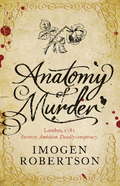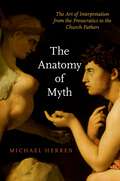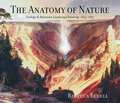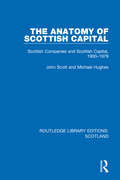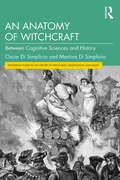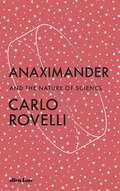- Table View
- List View
Anatomy of Murder: (Crowther & Westerman 2) (A\westerman And Crowther Mystery Ser. #2)
by Imogen Robertson'Makes you want to read every word...the plot is serpentine and satisfying, with enough false trails and distractions to create a genuine mystery'. Telegraph. The streets of London see the with rumour and conspiracy as the King's navy battles the French at sea. And while the banks of the Thames swarm with life, a body is dragged from its murky waters. In another part of town, where the air seems sweeter, the privileged enjoy a brighter world of complacent wealth and intoxicating celebrity. But as society revels in its pleasures, a darker plot is played out. Yet some are willing to look below the surface to the unsavoury depths. Mrs Harriet Westerman believes passionately in justice. Reclusive anatomist Gabriel Crowther is fascinated by the bones beneath the skin. Invited to seek the true nature of the dead man, they risk censure for an unnatural interest in murder. But when the safety of a nation is at stake, personal reputation must give way to the pursuit of reason and truth.
The Anatomy of Myth: The Art of Interpretation from the Presocratics to the Church Fathers
by Michael HerrenThe Anatomy of Myth is a comprehensive study of the different methods of interpreting myths developed by the Greeks, adopted by the Romans, and eventually passed on to Jewish and Christian interpreters of the Bible. Greek thinkers only rarely saw "myth" as a category of thought in its own right. Most often they viewed myths as the creation of poets, or else as an ancient revelation that had been corrupted by them. In the first instance, critics attempted to find in the intention of the authors some deeper truth, whether physical or spiritual; in the second, they deemed it necessary to clear away poetic falsehoods in order to recapture an ancient revelation. Parallel to the philosophical critiques were the efforts of early historians to explain myths as exaggerated history; myths could be purified by logos (reason) and rendered believable. Practically all of these early methods could be lumped under the term "allegory"--to intend something different from what one expressed. Only occasionally did philosophers veer from a concern for the literal truth of myths but a few thinkers, while acknowledging myths as fictions, defended their value for the examples of good and bad human behavior they offered. These early efforts were invaluable for the development of critical thinking, enabling public criticism of even the most authoritative texts. The Church Fathers took the interpretative methods of their pagan contemporaries and applied them vigorously to their reading of the scriptures. Pagan Greek methods of myth interpretation passed into the Middle Ages and beyond, serving as a perennial defense against the damaging effects of scriptural literalism and fundamentalism.
The Anatomy of Myth: The Art of Interpretation from the Presocratics to the Church Fathers
by Michael HerrenThe Anatomy of Myth is a comprehensive study of the different methods of interpreting myths developed by the Greeks, adopted by the Romans, and eventually passed on to Jewish and Christian interpreters of the Bible. Greek thinkers only rarely saw "myth" as a category of thought in its own right. Most often they viewed myths as the creation of poets, or else as an ancient revelation that had been corrupted by them. In the first instance, critics attempted to find in the intention of the authors some deeper truth, whether physical or spiritual; in the second, they deemed it necessary to clear away poetic falsehoods in order to recapture an ancient revelation. Parallel to the philosophical critiques were the efforts of early historians to explain myths as exaggerated history; myths could be purified by logos (reason) and rendered believable. Practically all of these early methods could be lumped under the term "allegory"--to intend something different from what one expressed. Only occasionally did philosophers veer from a concern for the literal truth of myths but a few thinkers, while acknowledging myths as fictions, defended their value for the examples of good and bad human behavior they offered. These early efforts were invaluable for the development of critical thinking, enabling public criticism of even the most authoritative texts. The Church Fathers took the interpretative methods of their pagan contemporaries and applied them vigorously to their reading of the scriptures. Pagan Greek methods of myth interpretation passed into the Middle Ages and beyond, serving as a perennial defense against the damaging effects of scriptural literalism and fundamentalism.
The Anatomy of Nature: Geology and American Landscape Painting, 1825-1875
by Rebecca BedellAn illuminating account of the interplay between science, religion, and nature in nineteenth-century landscape paintingGeology was in vogue in nineteenth-century America. People crowded lecture halls to hear geologists speak, and parlor mineral cabinets signaled social respectability and intellectual engagement. This was also the heyday of the Hudson River School, and many prominent landscape painters avidly studied geology. Thomas Cole, Asher Durand, Frederic Church, John F. Kensett, William Stanley Haseltine, Thomas Moran, and other artists read scientific texts, participated in geological surveys, and carried rock hammers into the field to collect fossils and mineral specimens. As they crafted their paintings, these artists drew on their geological knowledge to shape new vocabularies of landscape elements resonant with moral, spiritual, and intellectual ideas.Rebecca Bedell contributes to current debates about the relationship among art, science, and religion by exploring this phenomenon. She shows that at a time when many geologists sought to disentangle their science from religion, American artists generally sidestepped the era's more materialist science, particularly Darwinism. They favored a conservative, Christianized geology that promoted scientific study as a way to understand God. Their art was both shaped by and sought to preserve this threatened version of the science. And, through their art, they advanced consequential social developments, including westward expansion, scenic tourism, the emergence of a therapeutic culture, and the creation of a coherent and cohesive national identity.This major study of the Hudson River School offers an unprecedented account of the role of geology in nineteenth-century landscape painting. It yields fresh insights into some of the most influential works of American art and enriches our understanding of the relationship between art and nature, and between science and religion, in the nineteenth century. It will draw a broad audience of art historians, Americanists, historians of science, and readers interested in the American natural landscape.
The Anatomy of Nature: Geology and American Landscape Painting, 1825-1875
by Rebecca BedellAn illuminating account of the interplay between science, religion, and nature in nineteenth-century landscape paintingGeology was in vogue in nineteenth-century America. People crowded lecture halls to hear geologists speak, and parlor mineral cabinets signaled social respectability and intellectual engagement. This was also the heyday of the Hudson River School, and many prominent landscape painters avidly studied geology. Thomas Cole, Asher Durand, Frederic Church, John F. Kensett, William Stanley Haseltine, Thomas Moran, and other artists read scientific texts, participated in geological surveys, and carried rock hammers into the field to collect fossils and mineral specimens. As they crafted their paintings, these artists drew on their geological knowledge to shape new vocabularies of landscape elements resonant with moral, spiritual, and intellectual ideas.Rebecca Bedell contributes to current debates about the relationship among art, science, and religion by exploring this phenomenon. She shows that at a time when many geologists sought to disentangle their science from religion, American artists generally sidestepped the era's more materialist science, particularly Darwinism. They favored a conservative, Christianized geology that promoted scientific study as a way to understand God. Their art was both shaped by and sought to preserve this threatened version of the science. And, through their art, they advanced consequential social developments, including westward expansion, scenic tourism, the emergence of a therapeutic culture, and the creation of a coherent and cohesive national identity.This major study of the Hudson River School offers an unprecedented account of the role of geology in nineteenth-century landscape painting. It yields fresh insights into some of the most influential works of American art and enriches our understanding of the relationship between art and nature, and between science and religion, in the nineteenth century. It will draw a broad audience of art historians, Americanists, historians of science, and readers interested in the American natural landscape.
The Anatomy of Neo-Colonialism in Kenya: British Imperialism and Kenyatta, 1963–1978 (African Histories and Modernities)
by W. O. MalobaThe successor to Kenyatta and Britain: An Account of Political Transformation, 1929-1963, this book completes the first systematic political history of Jomo Kenyatta by examining the mechanisms of installing a neo-colonial regime in Kenya, and how such regimes were duplicated elsewhere in Africa. It analyzes the nature and extent of the collaboration between Kenyatta, Britain and Western intelligence services to install and protect his government in Kenya—a collaboration which is linked to some of Kenya's most intractable political, social and economic problems. Drawing heavily on primary sources, it examines the legacy of Kenyatta's regime, and how this legacy is felt in Kenya today.
Anatomy of Post-Communist European Defense Institutions: The Mirage of Military Modernity
by Thomas-Durell YoungAlthough the West won the Cold War, the continuation of the status quo is not a foregone conclusion. The former Soviet-aligned regions outside of Russia -- Ukraine, Poland, Czech Republic, and others -- sit atop decaying armed forces while Russian behavior has grown more and more aggressive, as evidenced by its intervention in Ukraine in recent years.Thomas Young delves into the state of these defense institutions in Central and Eastern Europe, whose resources have declined at a faster rate than their Western neighbors' due to social and fiscal circumstances at home and shifting attitudes in the wider international community. With rigorous attention to the nuances of each region's politics and policies, he documents the status of reform of these armed forces and the role that Western nations have played since the Cold War, as well as identifying barriers to success and which management practices have been most effective in both Western and Eastern capitals.This is essential reading for undergraduates and graduates studying the recent history of Europe in the post-Soviet era, as well as those professionally involved in defense governance in the region.
Anatomy of Post-Communist European Defense Institutions: The Mirage of Military Modernity
by Thomas-Durell YoungAlthough the West won the Cold War, the continuation of the status quo is not a foregone conclusion. The former Soviet-aligned regions outside of Russia -- Ukraine, Poland, Czech Republic, and others -- sit atop decaying armed forces while Russian behavior has grown more and more aggressive, as evidenced by its intervention in Ukraine in recent years.Thomas Young delves into the state of these defense institutions in Central and Eastern Europe, whose resources have declined at a faster rate than their Western neighbors' due to social and fiscal circumstances at home and shifting attitudes in the wider international community. With rigorous attention to the nuances of each region's politics and policies, he documents the status of reform of these armed forces and the role that Western nations have played since the Cold War, as well as identifying barriers to success and which management practices have been most effective in both Western and Eastern capitals.This is essential reading for undergraduates and graduates studying the recent history of Europe in the post-Soviet era, as well as those professionally involved in defense governance in the region.
The Anatomy of Scottish Capital: Scottish Companies and Scottish Capital, 1900-1979 (Routledge Library Editions: Scotland #27)
by John Scott Michael HughesOriginally published in 1980, this book gives a concrete description of the development of Scottish companies and Scottish capital through the 20th Century, based on empirical study. The study begins with the major companies of 1904-5 and examines their history and subsequent development. The top companies in a number of periods are also examined and the study concludes with an investigation of the major companies of 1973-4 and their response to the (then) recent oil developments. The book uses both detailed company histories and broad historical interpretations as sources drawing the data together into chronologically ordered sections. Its focus is on the companies and people which make up the system of Scottish capital, seen as a relatively distinct system with its own characteristics and its own pattern of development within the British system.
The Anatomy of Scottish Capital: Scottish Companies and Scottish Capital, 1900-1979 (Routledge Library Editions: Scotland #27)
by John Scott Michael HughesOriginally published in 1980, this book gives a concrete description of the development of Scottish companies and Scottish capital through the 20th Century, based on empirical study. The study begins with the major companies of 1904-5 and examines their history and subsequent development. The top companies in a number of periods are also examined and the study concludes with an investigation of the major companies of 1973-4 and their response to the (then) recent oil developments. The book uses both detailed company histories and broad historical interpretations as sources drawing the data together into chronologically ordered sections. Its focus is on the companies and people which make up the system of Scottish capital, seen as a relatively distinct system with its own characteristics and its own pattern of development within the British system.
The Anatomy of the Holocaust: Selected Works from a Life of Scholarship (Vermont Studies on Nazi Germany and the Holocaust #8)
by Raul Hilberg, Walter H. Pehle René SchlottThough best known as the author of the landmark 1961 work The Destruction of the European Jews, the historian Raul Hilberg produced a variety of archival research, personal essays, and other works over a career that spanned half a century. The Anatomy of the Holocaust collects some of Hilberg’s most essential and groundbreaking writings—many of them published in obscure journals or otherwise inaccessible to nonspecialists—in a single volume. Supplemented with commentary and notes from Hilberg’s longtime German editor and his biographer, it not only offers a multifaceted look at the man and the scholar, but also traces the evolution of Holocaust research from a marginal subdiscipline into a diverse and vital intellectual project.
Anatomy of the Red Brigades: The Religious Mind-set of Modern Terrorists
by Alessandro OrsiniThe Red Brigades were a far-left terrorist group in Italy formed in 1970 and active all through the 1980s. Infamous around the world for a campaign of assassinations, kidnappings, and bank robberies intended as a "concentrated strike against the heart of the State," the Red Brigades’ most notorious crime was the kidnapping and murder of Italy’s former prime minister Aldo Moro in 1978. In the late 1990s, a new group of violent anticapitalist terrorists revived the name Red Brigades and killed a number of professors and government officials. Like their German counterparts in the Baader-Meinhof Group and today’s violent political and religious extremists, the Red Brigades and their actions raise a host of questions about the motivations, ideologies, and mind-sets of people who commit horrific acts of violence in the name of a utopia. In the first English edition of a book that has won critical acclaim and major prizes in Italy, Alessandro Orsini contends that the dominant logic of the Red Brigades was essentially eschatological, focused on purifying a corrupt world through violence. Only through revolutionary terror, Brigadists believed, could humanity be saved from the putrefying effects of capitalism and imperialism. Through a careful study of all existing documentation produced by the Red Brigades and of all existing scholarship on the Red Brigades, Orsini reconstructs a worldview that can be as seductive as it is horrifying. Orsini has devised a micro-sociological theory that allows him to reconstruct the group dynamics leading to political homicide in extreme-left and neonazi terrorist groups. This "subversive-revolutionary feedback theory" states that the willingness to mete out and suffer death depends, in the last analysis, on how far the terrorist has been incorporated into the revolutionary sect. Orsini makes clear that this political-religious concept of historical development is central to understanding all such self-styled "purifiers of the world." From Thomas Müntzer’s theocratic dream to Pol Pot’s Cambodian revolution, all the violent "purifiers" of the world have a clear goal: to build a perfect society in which there will no longer be any sin and unhappiness and in which no opposition can be allowed to upset the universal harmony. Orsini’s book reconstructs the origins and evolution of a revolutionary tradition brought into our own times by the Red Brigades.
Anatomy of Torture
by Ron E. HassnerDoes torture "work?" Can controversial techniques such as waterboarding extract crucial and reliable intelligence? Since 9/11, this question has been angrily debated in the halls of power and the court of public opinion. In Anatomy of Torture, Ron E. Hassner mines the archives of the Spanish Inquisition to propose an answer that will frustrate and infuriate both sides of the divide. The Inquisition's scribes recorded every torment, every scream, and every confession in the torture chamber. Their transcripts reveal that Inquisitors used torture deliberately and meticulously, unlike the rash, improvised methods used by the United States after 9/11. In their relentless pursuit of underground Jewish communities in Spain and Mexico, the Inquisition tortured in cold blood. But they treated any information extracted with caution: torture was used to test information provided through other means, not to uncover startling new evidence. Hassner's findings in Anatomy of Torture have important implications for ongoing torture debates. Rather than insist that torture is ineffective, torture critics should focus their attention on the morality of torture. If torture is evil, its efficacy is irrelevant. At the same time, torture defenders cannot advocate for torture as a counterterrorist "quick fix": torture has never located, nor will ever locate, the hypothetical "ticking bomb" that is frequently invoked to justify brutality in the name of security.
An Anatomy of Witchcraft: Between Cognitive Sciences and History (Routledge Studies in the History of Witchcraft, Demonology and Magic)
by Oscar Di Simplicio Martina Di SimplicioMuch has been written on witchcraft by historians, theologians, philosophers, and anthropologists, but nothing by scientists. This book aims to reappraise witchcraft by applying to it the advances in cognitive sciences. The book is divided into four parts. Part I ("Deep History") deals with human emotions and the drive to represent witches as evil female agents. Part II ("Historical Times") focuses on those rare state and church repressions of malefice, which, surprisingly, did not feature in Islamic lands. Modern urbanization dealt a blow to the rural civilizations where accusations of witchcraft were rife. Part III ("In the Laboratory") applies neuroscience to specific case studies to investigate the personification of misfortune, the millenary stereotype witch = woman, the reality of evil, and the phenomenon of treasure hunting. Part IV ("Millenials") wonders whether intentional malefic hatred in a closed chapter in the history of humanity. An Anatomy of Witchcraft is ideal reading for students and scholars. Given its interdisciplinary nature, the book will be of interest to scholars from many fields including evolutionary psychology, anthropology, women’s history, and cognitive sciences.
An Anatomy of Witchcraft: Between Cognitive Sciences and History (Routledge Studies in the History of Witchcraft, Demonology and Magic)
by Oscar Di Simplicio Martina Di SimplicioMuch has been written on witchcraft by historians, theologians, philosophers, and anthropologists, but nothing by scientists. This book aims to reappraise witchcraft by applying to it the advances in cognitive sciences. The book is divided into four parts. Part I ("Deep History") deals with human emotions and the drive to represent witches as evil female agents. Part II ("Historical Times") focuses on those rare state and church repressions of malefice, which, surprisingly, did not feature in Islamic lands. Modern urbanization dealt a blow to the rural civilizations where accusations of witchcraft were rife. Part III ("In the Laboratory") applies neuroscience to specific case studies to investigate the personification of misfortune, the millenary stereotype witch = woman, the reality of evil, and the phenomenon of treasure hunting. Part IV ("Millenials") wonders whether intentional malefic hatred in a closed chapter in the history of humanity. An Anatomy of Witchcraft is ideal reading for students and scholars. Given its interdisciplinary nature, the book will be of interest to scholars from many fields including evolutionary psychology, anthropology, women’s history, and cognitive sciences.
Anaximander: A Re-assessment
by Andrew GregoryAnaximander, the sixth-century BCE philosopher of Miletus, is often credited as being the instigator of both science and philosophy. The first recorded philosopher to posit the idea of the boundless cosmos, he was also the first to attempt to explain the origins of the world and humankind in rational terms. Anaximander's philosophy encompasses theories of justice, cosmogony, geometry, cosmology, zoology and meteorology. Anaximander: A Re-assessment draws together these wide-ranging threads into a single, coherent picture of the man, his worldview and his legacy to the history of thought. Arguing that Anaximander's statements are both apodeictic and based on observation of the world around him, Andrew Gregory examines how Anaximander's theories can all be construed in such a way that they are consistent with and supportive of each other. This includes the tenet that the philosophical elements of Anaximander's thought (his account of the apeiron, the extant fragment) can be harmonised to support his views on the natural world. The work further explores how these theories relate to early Greek thought and in particular conceptions of theogony and meterology in Hesiod and Homer.
Anaximander: A Re-assessment
by Andrew GregoryAnaximander, the sixth-century BCE philosopher of Miletus, is often credited as being the instigator of both science and philosophy. The first recorded philosopher to posit the idea of the boundless cosmos, he was also the first to attempt to explain the origins of the world and humankind in rational terms. Anaximander's philosophy encompasses theories of justice, cosmogony, geometry, cosmology, zoology and meteorology. Anaximander: A Re-assessment draws together these wide-ranging threads into a single, coherent picture of the man, his worldview and his legacy to the history of thought. Arguing that Anaximander's statements are both apodeictic and based on observation of the world around him, Andrew Gregory examines how Anaximander's theories can all be construed in such a way that they are consistent with and supportive of each other. This includes the tenet that the philosophical elements of Anaximander's thought (his account of the apeiron, the extant fragment) can be harmonised to support his views on the natural world. The work further explores how these theories relate to early Greek thought and in particular conceptions of theogony and meterology in Hesiod and Homer.
Anaximander: And the Nature of Science
by Carlo RovelliNow widely available in English for the first time, this is Carlo Rovelli's first book: the thrilling story of a little-known man who created one of the greatest intellectual revolutions Over two thousand years ago, one man changed the way we see the world.Since the dawn of civilization, humans had believed in the heavens above and the Earth below. Then, on the Ionian coast, a Greek philosopher named Anaximander set in motion a revolution. He not only conceived that the Earth floats in space, but also that animals evolve, that storms and earthquakes are natural, not supernatural, that the world can be mapped and, above all, that progress is made by the endless search for knowledge. Carlo Rovelli's first book, now widely available in English, tells the origin story of scientific thinking: our rebellious ability to reimagine the world, again and again.Translated by Marion Lignana Rosenberg
Ancestor Worship and the Elite in Late Iron Age Scandinavia: A Grave Matter (Studies in Medieval History and Culture)
by Triin LaidonerAncestor worship is often assumed by contemporary European audiences to be an outdated and primitive tradition with little relevance to our societies, past and present. This book questions that assumption and seeks to determine whether ancestor ideology was an integral part of religion in Viking Age and early medieval Scandinavia. The concept is examined from a broad socio-anthropological perspective, which is used to structure a set of case studies which analyse the cults of specific individuals in Old Norse literature. The situation of gods in Old Norse religion has been almost exclusively addressed in isolation from these socio-anthropological perspectives. The public gravemound cults of deceased rulers are discussed conventionally as cases of sacral kingship, and, more recently, religious ruler ideology; both are seen as having divine associations in Old Norse scholarship. Building on the anthropological framework, this study introduces the concept of ‘superior ancestors’, employed in social anthropology to denote a form of political ancestor worship used to regulate social structure deliberately. It suggests that Old Norse ruler ideology was based on conventional and widely recognised religious practices revolving around kinship and ancestors and that the gods were perceived as human ancestors belonging to elite families.
Ancestor Worship and the Elite in Late Iron Age Scandinavia: A Grave Matter (Studies in Medieval History and Culture)
by Triin LaidonerAncestor worship is often assumed by contemporary European audiences to be an outdated and primitive tradition with little relevance to our societies, past and present. This book questions that assumption and seeks to determine whether ancestor ideology was an integral part of religion in Viking Age and early medieval Scandinavia. The concept is examined from a broad socio-anthropological perspective, which is used to structure a set of case studies which analyse the cults of specific individuals in Old Norse literature. The situation of gods in Old Norse religion has been almost exclusively addressed in isolation from these socio-anthropological perspectives. The public gravemound cults of deceased rulers are discussed conventionally as cases of sacral kingship, and, more recently, religious ruler ideology; both are seen as having divine associations in Old Norse scholarship. Building on the anthropological framework, this study introduces the concept of ‘superior ancestors’, employed in social anthropology to denote a form of political ancestor worship used to regulate social structure deliberately. It suggests that Old Norse ruler ideology was based on conventional and widely recognised religious practices revolving around kinship and ancestors and that the gods were perceived as human ancestors belonging to elite families.
Ancestors: The story of China told through the lives of an extraordinary family
by Frank ChingFrank Ching brings to life 900 years of Chinese history through his own fascinating family tree. Beginning with his search for the grave of his first recorded ancestor, the 11th century poet Qin Guan, and ending with a moving account of his relationship with his father, a victim of China's historic upheaval, Frank Ching introduces a colourful cast of characters. His unbroken family line includes - among many others - a lovelorn concubine, a traitor, a military hero, an imperial ghost-writer, a minister of punishments and a woman noted for her skills in both verse and martial arts. There is scarcely an aspect of Chinese life, from shamanism to violent rebellion, that Ching doesn't touch upon in this fascinating work. Through his vivid and personal portraits of his ancestors the history of China itself unfolds: from the days of the ancient empire to its radical transformation today.
Ancestors: The Loving Family in Old Europe
by Steven OzmentRescuing the premodern family from the grim picture many historians have given us of life in early Europe, Ancestors offers a major reassessment of a crucial aspect of European history--and tells a story of age-old domesticity inextricably linked, and surprisingly similar, to our own. An elegant summa on family life in Europe past, this compact and powerful book extends and completes a project begun with Steven Ozment's When Fathers Ruled: Family Life in Reformation Europe (Harvard). Here Ozment, the leading historian of the family in the middle centuries, replaces the often miserable depiction of premodern family relations with a delicately nuanced portrait of a vibrant and loving social group. Mining the records of families' private lives--from diaries and letters to fiction and woodcuts--Ozment shows us a preindustrial family not very different from the later family of high industry that is generally viewed as the precursor to the sentimental nuclear family of today. In Ancestors, we see the familiar pattern of a domestic wife and working father in a home in which spousal and parental love were amply present: parents cherished their children, wives were helpmeets in providing for the family, and the genders were nearly equal. Contrary to the abstractions of history, parents then--as now--were sensitive to the emotional and psychological needs of their children, treated them with affection, and gave them a secure early life and caring preparation for adulthood. As it recasts familial history, Ancestors resonates beyond its time, revealing how much the story of the premodern family has to say to a modern society that finds itself in the throes of a family crisis.
Ancestors on the Move: A History of Overseas Travel
by Karen FoyEver wanted to understand more about your ancestor’s sea travels? What was life like aboard ship for both passengers and crew, how long did the journey take, what kind of conditions could be expected and what exotic locations might they have visited along the way? Following the tried and tested routes established by cargo ships, Karen Foy describes the development of passenger travel, the changing face of the vessels used and the demand for both comfort and speed. From transportation to trade, adventure to emigration, through persecution or for pleasure, she explains the reasons behind our ancestor’s desire for overseas travel and reveals the records and archives we can search to complete our own genealogical journey.
Ancestral Knowledge Meets Computer Science Education: Environmental Change in Community (Postcolonial Studies in Education)
by Cueponcaxochitl D. SandovalThis book illustrates a pathway for knowledge production to benefit from interweaving the seemingly disparate historical experiences of Indigenous Peoples and computer science education. The resulting practice of ancestral computing for sustainability holds the power to mitigate the destructive forces of the field, while extending the potential of traditionally underserved and unheard populations. Reimagining the field of computer science, interwoven with traditional lifeways, presents compelling new discoveries in research and harnesses the rich tapestries that are Indigenous populations. Returning healthy lifeways to a center stage long-occupied by tightly controlled, Eurocentric learning methods opens worlds of opportunity that have felt lost to time.
Ancestral Voices in Irish Politics: Judging Dillon and Parnell
by Prof Paul BewThe story of Charles Stewart Parnell, one of the greatest Irish leaders of the nineteenth century and also one of the most renowned figures of the 1880s on the international stage, and John Dillon, the most celebrated of Parnell's lieutenants. As Paul Bew shows, the differences between the two men reflect both Ireland's past and its future. The story of Charles Stewart Parnell, one of the greatest Irish leaders of the nineteenth century and also one of the most renowned figures of the 1880s on the international stage, and John Dillon, the most celebrated, but also the most neglected, of Parnell's lieutenants. As Paul Bew shows, the differences between the two men reflect both Ireland's past and its future. Every time the principle of consent for a united Ireland is discussed today, we can perceive the legacy of both men. Even more profoundly, that legacy can be seen when Irish nationalism tries to transcend a tribalist outlook based on the historic Catholic nation, even when the country is no longer so very Catholic.
